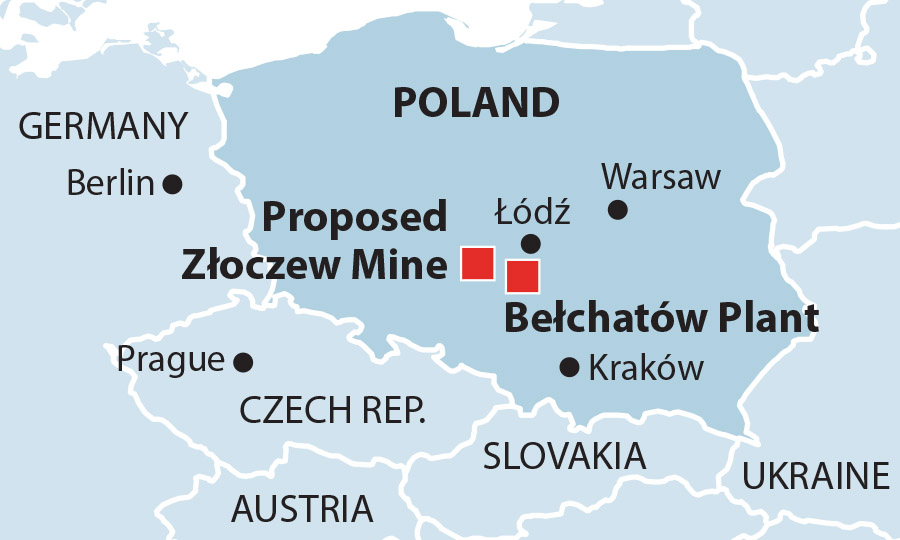IEEFA update: Poland’s PGE should ditch plans for new lignite mine

 October 8, 2019 (WARSAW) ‒ PGE, Poland’s biggest electric utility, one of the most coal- and carbon-intensive energy companies in Europe, risks prolonging serious, recent financial under-performance, if it endorses a forthcoming strategy that continues to support coal, gas and a new lignite mine, delaying the replacement of fossil fuels with renewables, according to a report released today by the Institute for Energy Economics and Financial Analysis (IEEFA).
October 8, 2019 (WARSAW) ‒ PGE, Poland’s biggest electric utility, one of the most coal- and carbon-intensive energy companies in Europe, risks prolonging serious, recent financial under-performance, if it endorses a forthcoming strategy that continues to support coal, gas and a new lignite mine, delaying the replacement of fossil fuels with renewables, according to a report released today by the Institute for Energy Economics and Financial Analysis (IEEFA).
The report, To Embrace a Profitable Energy Future, Poland’s PGE Must Abandon Plans for a New Lignite Mine, reviews PGE’s recent financial performance, and takes a close look at PGE’s iconic Bełchatów power plant, the world’s largest lignite power plant, Europe’s biggest power plant of any kind and the continent’s single largest source of carbon emissions.
PGE is seeking a concession to open a new lignite mine, Złoczew, to fuel the Bełchatów power plant for the next several decades.
Poland should transition to more affordable, less polluting, low-carbon alternatives
“It makes no financial sense for PGE to plan for lignite several decades ahead, with a new mine that would cost billions of euros, when it is clear that Poland’s energy system will have to transition away from coal to more affordable, less polluting, low-carbon alternatives long before then,” said Gerard Wynn, an IEEFA energy analyst and co-author of the report.
“PGE itself recognises the challenges it faces, in particular higher carbon prices, and now needs to be more explicit and ambitious about how it is going to replace dwindling profits from coal and lignite in the near and medium term. The proposed Złoczew lignite mine is a distraction which would inevitably create huge losses, ultimately paid by energy consumers or the Polish state. The time has passed for energy companies to replace old coal with new coal.”
THE REPORT REVIEWS PAST, PRESENT AND FUTURE STRATEGIES AT PGE, AND FINDS AN EXTREMELY ADVERSE AND WORSENING ENVIRONMENT FOR COAL AND LIGNITE GENERATION IN EUROPE.
“We expect utilities in Europe will cease coal and lignite power generation in the 2030s at the latest, either by mandate or market forces,” said Wynn.
Coal and lignite in Poland are partly a social issue, employing hundreds of thousands of people. But the greater long-term profitability and lower risk of renewables, as illustrated in the report, shows that even in the near-term there would be no winners if PGE were to move ahead with coal development plans.
Among the main findings:
- PGE’s record PLN 37 billion (€8.5 billion) outlay under its 2015-2020 strategy to date has had a negative impact on the company’s financial performance.
- Coal and lignite have accounted for 76% of this capex and acquisition investment. Renewables accounted for 3%. Coal and lignite earnings (EBITDA) have fallen year-on-year in the same period, while renewables EBITDA has risen.
- PGE’s cost of equity has exceeded return on equity for at least the last four years, indicating that PGE has destroyed shareholder capital.
- PGE has performed poorly compared with European electric utilities that have tilted towards renewables.
TO ILLUSTRATE PGE’S ALTERNATIVE OPTIONS, THE REPORT ANALYZED THE CASH FLOW IMPACT OF CLOSING BEŁCHATÓW POWER PLANT’S THREE OLDEST UNITS, CLEANING UP THEIR SHARE OF THE POWER PLANT SITE and lignite mine, and then developing ground-mounted solar and warehouse rental businesses, versus the alternative of continuing lignite generation for another five years.
Ground-mounted solar and warehouse rental achieved earnings similar to lignite
“We found that ground-mounted solar and warehouse rental achieved similar earnings (EBITDA) as lignite, with zero subsidies, not only for five years or so but for decades into the future,” said energy economist and report co-author Paolo Coghe.
Such alternatives also generated healthy value, notwithstanding the cost of first cleaning up the associated coal infrastructure, if they used available EU funds dedicated for this purpose. The report found that it was vital that PGE take urgent advantage of such funding to transition to alternative economic uses for its fossil fuel sites. New, co-located employment, whether in industrial warehousing and data centres, or low-carbon electricity generation, has a long-term future, unlike coal and lignite generation, the report said.
Authors
Gerard Wynn ([email protected]) is an IEEFA energy finance consultant based in London.
Paolo Coghe is an energy economist based in Paris.
Full report: To Embrace a Profitable Energy Future, Poland’s PGE Must Abandon Plans for a New Lignite Mine
Media contacts
U.S.: Sandy Buchanan ([email protected]) +1 (216) 314-0180
Poland: Kuba Gogolewski ([email protected]) +48 661 862 611
About IEEFA
The Institute for Energy Economics and Financial Analysis (IEEFA) conducts global research and analyses on financial and economic issues related to energy and the environment. The Institute’s mission is to accelerate the transition to a diverse, sustainable and profitable energy economy.










